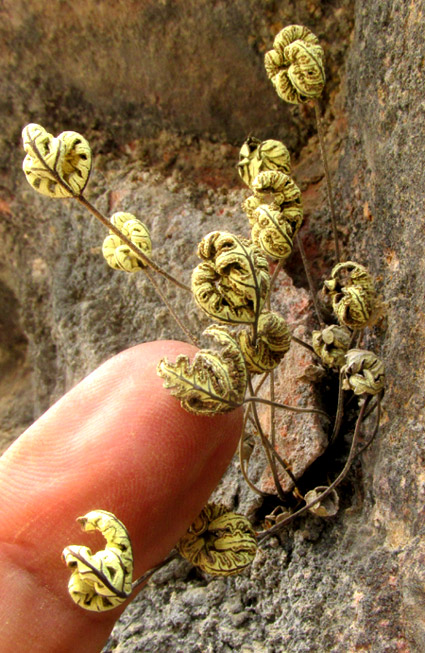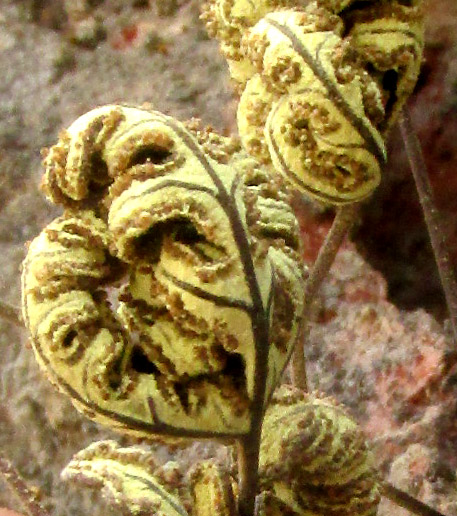Excerpts from Jim Conrad's
Naturalist Newsletter
Entry from field notes dated August 31, 2023, taken in Los Mármoles National Park in the Eastern Sierra Madre mountains, Hidalgo state, MÉXICO, along steeply climbing road heading eastward out of town of Trancas {on maps designated "Morelos (Trancas)"} toward Nicolás Flores; juniper/pine forest on limestone bedrock; elevation ~2,300m (~7,550ft); ~N20.80°, ~W99.25°
"CLOAK FERN"

The above unusually small fern grew from a crack in a limestone wall along the road. It's curled up and brittle because it hasn't rained for weeks. Several fern species dry into similarly contorted states, but this one caught my eye not only because of its smallness but also for the faint yellowish or orangish hue tinting its leaves' pale undersurfaces. Other species with similar leaf undersurfaces are pure white or silvery. At first I suspected the hue was a trick of lighting, but my finger showed its usual color, so fern's hue must have been accurate.

Up close, the leaf's branching black midribs on the pale background was reminiscent of acanthus decorations on column capitals of ancient Roman ruins. Note the fern's granular, spore-producing sporangia forming neat continuous lines along the divisions' margins.
Also notice the leaf's basic structure. Overall, the blade when moist and fully expanded is triangular, or deltate. It's a compound blade, with two separate pinnae at the triangle's bottom, with the rest of the leaf above the pinnae deeply lobed but not divided into separate divisions. Our fern is "runty," or depauperate, because of water scarcity. In moister situations the leaves can grow up to 17cm long (6.7inches), and develop more lobes.

Above we see two pinna tips. Note how mealy the white surfaces look. The pale covering must drastically reduce water loss, and protect tissue from intense high-elevation sunlight. In numerous fern species, leaf margins curl under to produce "false indusia" at least partially sheltering the sporangia. This fern appears to have usually weakly developed false indusia.
Identifying our fern was tricky, largely because there's been such confusion about how to classify it -- where it belongs on the phylogenetic Tree of Life. In the end, the easiest way I found to identify it was to do an image search on Mexican ferns with white undersurfaces. The whiteness technically is known as "farina." In general English, farina is meal or flour ground from cereal grains, nuts or starchy roots. In the fern world, the 2019 study by Tzu-Tong Kao and others entitled "Low-copy nuclear sequence data confirm complex patterns of farina evolution in notholaenid ferns (Pteridaceae)," fern farina is referred to as "... powdery exudates formed by specialized glands concentrated on the abaxial {lower} surface..."
Our fern revealed itself to be HEMIONITIS SULPHUREA. It's known by no English name, though it belongs to a group of ferns whose various species often are known as cloak ferns; the ambiguity of that name accounts for the quotation marks used in the title. The species is native from Mexican uplands spottily south to Argentina, in South Amearica mainly in the Andes. Hemionitis sulphurea is described as living on limestone or other calcium-rich rock in a variety of upland habitats, including rarely in temperate and oak forests.
At this time, Hemionitis sulphurea is the name accepted by Kew Garden's Plants of the World database, but the similarly authoritative GBIF database regards that name as a synonym of Notholaena sulphurea, which is what it's known as in most literature more than a year old. This is typical of our plant's taxonomic history. In the past, besides Notholaena, our fern has been assigned to the genera Aleuritopteris, Allosorus, Cheilanthes, Chrysochosma and Pteris. Even the name cloak fern is applied to various species scattered among various genera.
There's a very similar fern which both the Kew and GBIF database currently name Notholaena standleyi, also occurring in our area, though less frequently than our Notholaena sulphurea. At first glance, the two species appear to be identical, but the Flora del Bajío points to subtle differences in relative sizes of the second pair of pinnae, and at what point the leaf above the bottom pinnae becomes deeply lobed but not divided into separate divisions. Interestingly, the earlier-mentioned work by Tzu-Tong Kao and others found that the chemistry of farina on Notholaena standleyii and our Hemionitis sulphurea is very different, " suggesting that the morphological similarities might be the result of convergent evolution."
Our fern's farina is interesting stuff. The 2018 study by A.M. Rodriguez and other entitled "Bioactive farina of Notholaena sulphurea (Pteridaceae): Morphology and histochemistry of glandular trichomes," found that our fern's farina not only is protective against environmental extremes, but also "The farina showed antifungal and molluscicidal activity," thus may deter herbivores from eating it, and protect against fungal attack.
The above study also notes that our fern's pale farina undersurface exhibits geographically correlated variations across the species' distribution area. Three "chemotypes" have been recognized: cream, orange and yellow. I'm unsure which ours would represent.
So, here's a simple little fern that hardly anyone notices, but which researchers find endlessly fascinating and somewhat confusing.